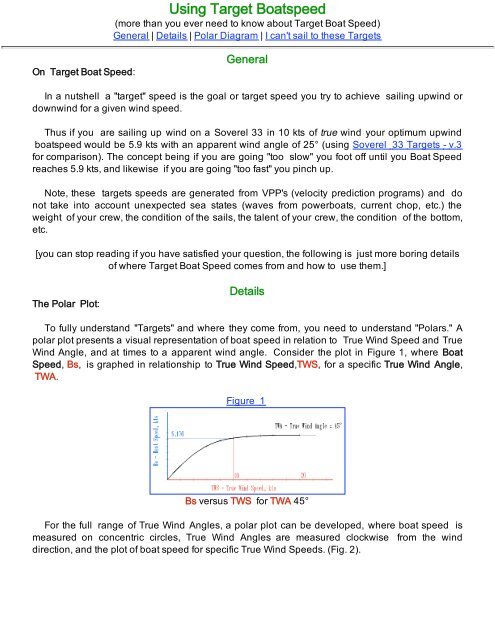Create successful ePaper yourself
Turn your PDF publications into a flip-book with our unique Google optimized e-Paper software.
Definition:<strong>Target</strong> Speed:The "<strong>Target</strong>" speed is the optimum upwind or downwind point on the polar diagram, that willget you upwind or downwind the fastest. The Polars show that <strong>Target</strong> Boat Speed, whensustained over a long period, will produce the best VMG, velocity made good, for upwind anddownwind sailing, where tacking and jybing are a necessity.How do you utilize <strong>Target</strong>s:To some <strong>Target</strong> Boat Speed, is the "single most important value" to use for beating upwind andtacking downwind for maximum performance. The crew utilizes target speed as the primaryindicator for maintaining the highest potential of the boat upwind and downwind, with constantinteraction between helmsman, tactician, and sail trimmers.<strong>Target</strong> Speed [theoretical goals]:1. develop the best speed for maximization of performance.2. compensates for sailing too high (pinching) and too low (footing).3. compensates for changes in sea conditions: smooth water torough water.4. allows you to trim sails to optimum angle [in theory, the jibTelltales are for trimmers only, and the helmsman watches the BoatSpeed]5. promote good team work: sail trimmer, helmsman and tacticiancoordination6. compensates for different wind velocities7. promotes proper response to velocity shifts as a result of changesin wind velocity.Other thoughts on <strong>Target</strong>s:The best "targets" you can get are developed thought experience. In other words, how doesyour speed and point compare with other boats.Your own testing and date recording before and during races is extremely valuable data. Youcan construct your own set of Polars, or update existing Polars with footnotes of sail selection,lead position, halyard tension, and sea conditions.Details:Consider both VMG and the Polar Chart together. From the Polars (Fig. 3) you know that the<strong>Target</strong> Speed point is the boat speed that maximizes VMG for a particular True Wind Speed.(Figure 7)
"Too slow," bear offIf you are "too slow:"1. Trimmer should ease sails to allow you to bear off and accelerate.2. Helmsman should call out: "below target, ease sheets bearing off."3. As the boat speed builds towards <strong>Target</strong>, Trimmer starts to trim. Helmsmanslowly starts bringing the boat back to close hauled.4. When Boat Speed reaches upwind target, Helmsman call out: "Boat Speed attarget, full upwind trim" and Helmsman settles in at target Speed upwind.Again, this is terrifically positive and productive interaction between the crew for maintainingmaximum performance upwind. As the previous example, this coordination of Helmsman,Trimmer, and <strong>Target</strong> Boat Speed allows you to maintain maximum performance when you enter arough patch of water - sailing through a current rip - or backwash near a shore. As the boat entersthe rough water and Boat Speed slows, you reestablish target speed quickly, allowing you topreserve your maximum performance level.Compensating for Sea Conditions.<strong>Target</strong> speed can compensate for overall sea conditions:1. In smooth water, the boat is able to sail to <strong>Target</strong> speed while pointing high. Theaverage sailing angle is closer to the wind, and target speed is maintained. Thesame rules apply during shorter changes in sea state - too fast, head up; too slow,bear off.2. In rough seas, the <strong>Target</strong> Speed will remain the same, but the average windangle will be wider, and you will have to sail lower because of the sea conditions.However the theory of target speed s hold true: too fast, head up; too slow, bearoff.
I'm not competitive when I sail to the <strong>Target</strong>s!The <strong>Target</strong>s posted here on the website are for the individual boats as noted. For instance, the<strong>Target</strong>s for Deviation are for using a 143% headsail, with a 14' OD size girth Spinnaker. Thus ifyou have tried the <strong>Target</strong>s, and have failed to be satisfied, then you can establish your own,through trial and error, which is optimized for you own boat, set up , and style of sailing.The best "targets" you can get are developed thought experience. In other words, how does yourspeed and point compare with other boats.Your own testing and date recording before and during races is extremely valuable data. Youcan construct your own set of polars, or update existing polars with footnotes of sail selection,lead position, halyard tension, and sea conditions.TWS Upwind / SailDownwind3 2.4 / 143% 2.1 / 0.6 oz.5 4.0 / 143% 3.7 / 0.6 oz.8 5.6 / 143% 5.5 / 0.6 oz.10 5.9 / 143% 6.0 / 0.6 oz.12 6.0 / 143% 6.4 / 0.6 oz.13 6.1 / 105% 6.6 / 0.6 oz.15 6.2 / 105% 7.0 / 0.6 oz.18 6.3 / 105% 7.8 / 0.6 oz.20 6.3 / 105% 8.2 / 0.6 oz.23 6.3 / 105% 8.8 / 0.6 oz.25 6.4 / 105% 9.3 / 0.6 oz.30 6.5 / 90% 10.7 / 0.6 oz.Sample Duct Tape Strips (re. Deviation 2002)Three pieces of duct tape in the cockpit can be the most guide on the boat. With True WindSpeed on the first piece of tape, <strong>Target</strong> Boat Speed and Headsail for upwind and <strong>Target</strong> Speedfor downwind sailing. Use the true wind function to reference the target speed. Continuouslychecking boat speed against target speed will maximize your performance. As True windchanges, check your new target speed and respond to maintain maximum performance.Example:1. Helmsman checks True Wind Speed,2. Helmsman identifies target speed for that True Wind Speed.3. Helmsman checks boat speed in relation to target speed.4. If boat speed is slow, Helmsman communicates with the Trimmerto ease the sails, bears off, accelerates, and re-trimms5. Helmsman then rechecks True Wind Speed, and so on . . .
















